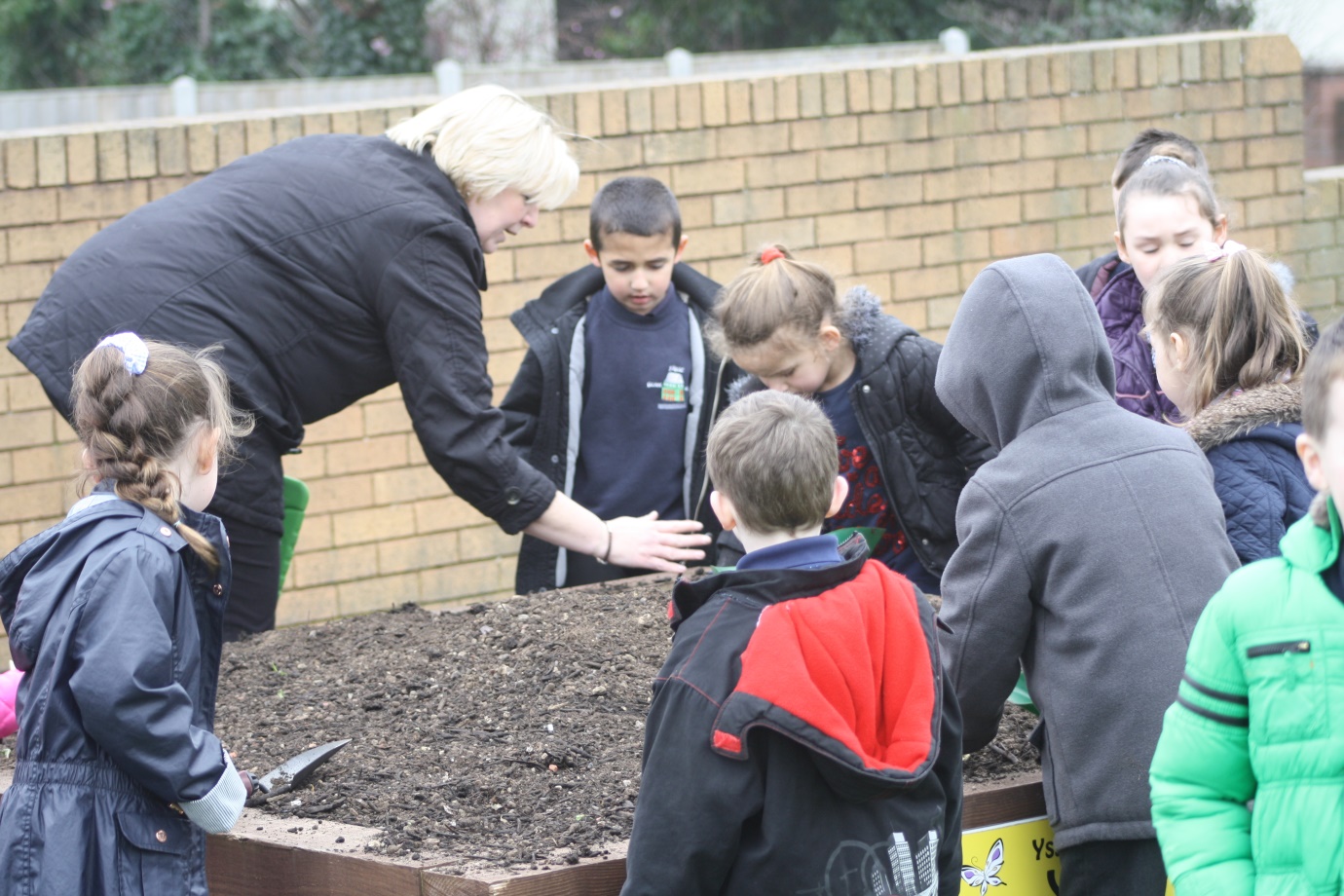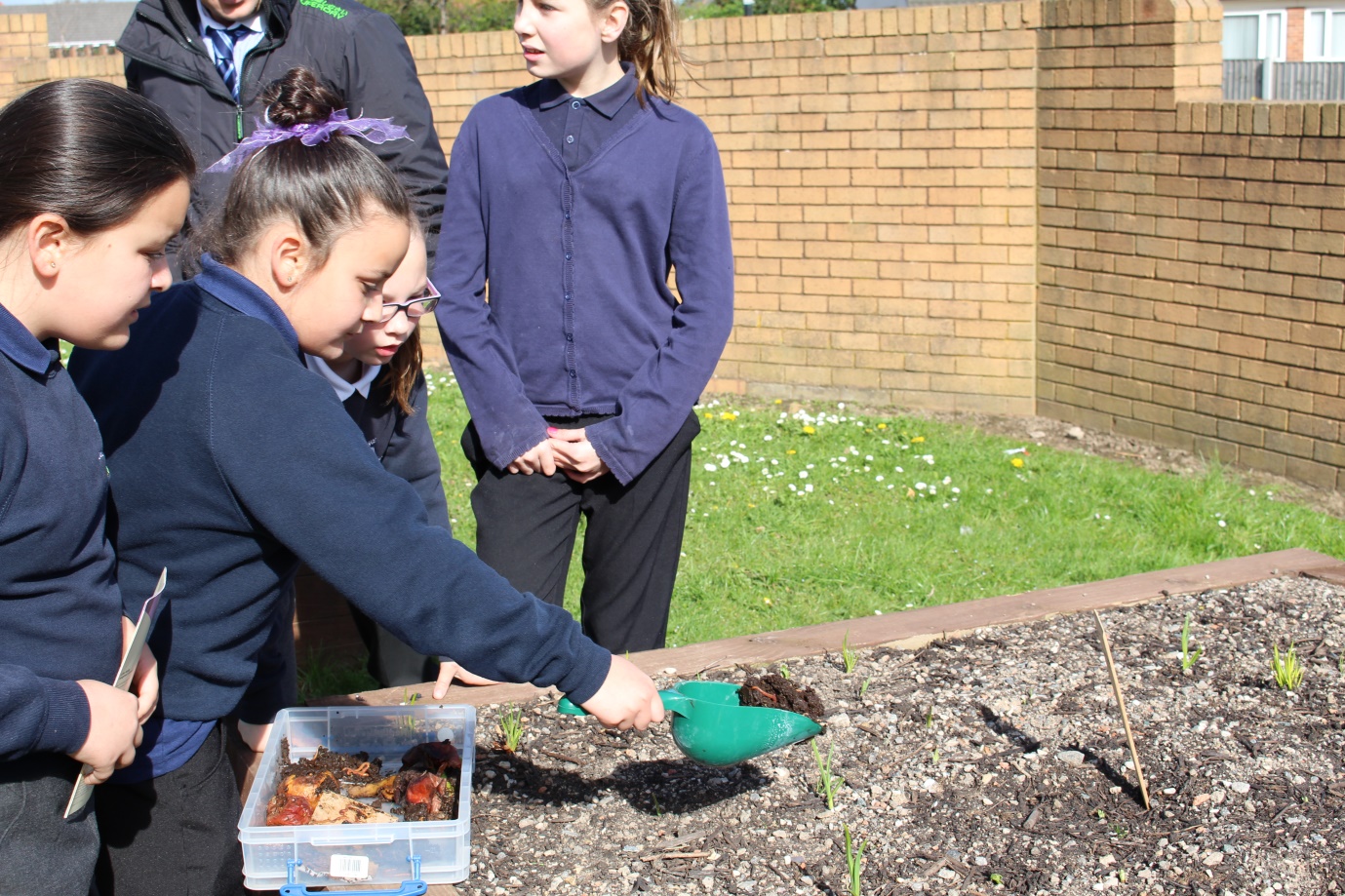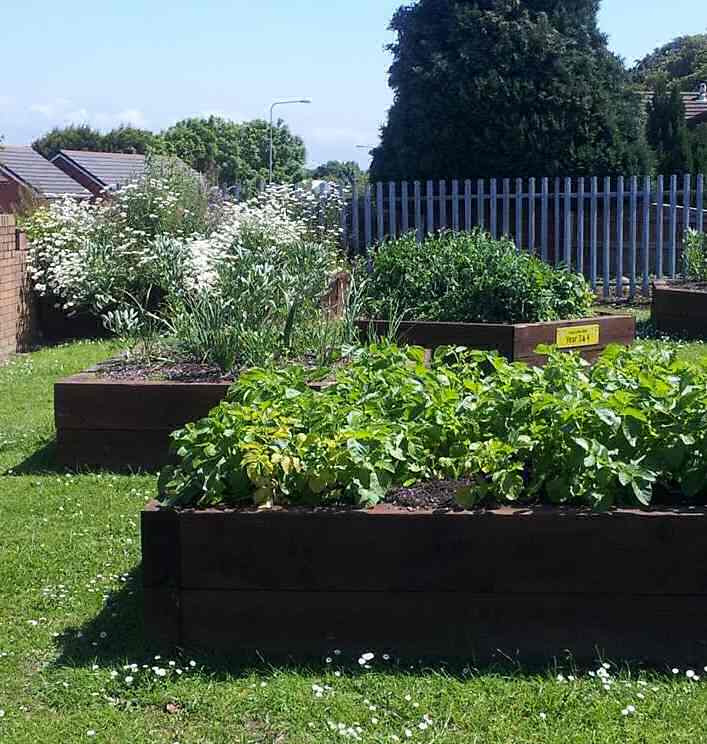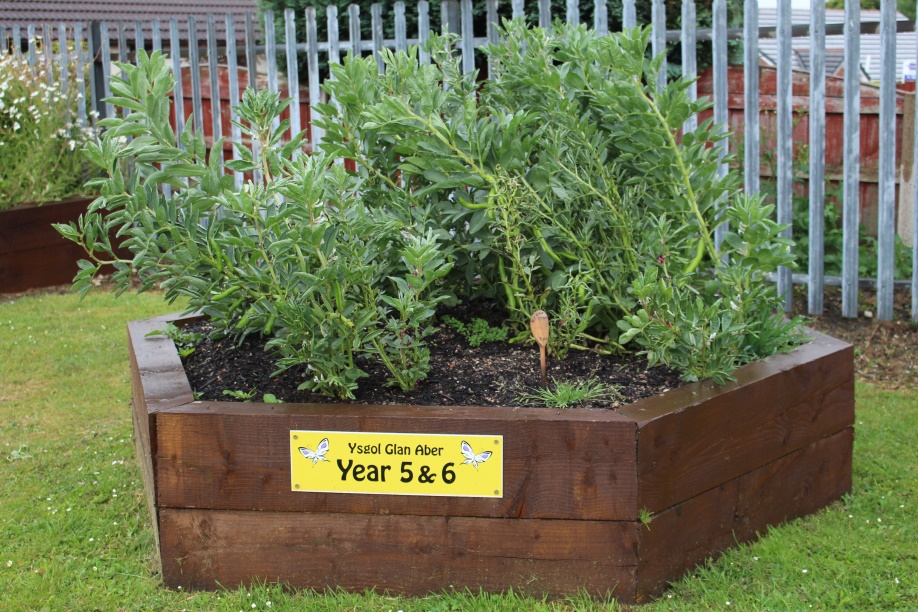- Home
- Public Benefits
- Gardening & people
- Education
- Case studies
- Jan Miller
Case Study: Primary School Vegetable Garden project
By Jan Miller
As a volunteer for Butterfly Conservation and the North Wales Wildlife Trust, I have designed and planted many school wildlife gardens in North Wales over 10 years or more, with varying degrees of success. But how do you measure ‘success’ in a wildlife garden? Is it about continuity of habitat and species conservation; is it about continuity of the childrens’ experience from year to year, or can it actually be counted a success if on just one day you have woken up one child to the possibilities of nature, gardening and wildlife?
Even if your school garden project doesn’t get watered, gets vandalised, gets overgrown with brambles by next year; it can still have been worth doing for the children who will remember the fun and interest it provided into later life.
Why a project on growing vegetables?
Some head techers will not be very keen on the idea of a wildlife garden as they can't immediately understand how it would advance their National Curriculum and league table goals. But growing vegetables is very much in the news just now, and many teachers are more interested in that than in wildlife. It is easy to see how modules on how plants grow, healthy eating etc. can be covered. Furthermore, you can bring an appreciation and study of wildlife and the natural environment into growing vegetables. Vegetables in tubs will all be harvested within the year, and the cycle - with variations can be used again.
Aims of the vegetable garden programme;
1.National Curriculum Science Key stages 1 to 6. Topics covered include; plant growth, minibeasts, climate, life cycle of the butterfly, healthy eating, and others….? It is useful to ask the class teacher(s) for their input on topics they need to satisfy National Curriculum for their age groups.
2. Healthy eating; why we need vegetables; vitamins, minerals, fibre, protein; the five food groups. Preparing and cooking vegetables
3.Link to biodiversity and the natural world; minibeasts found in the soil, life cycle of earthworm, what soil is made of, food chains, disease, contamination; Pollination – life cycle of the butterfly and how different bees live.
Starting to plant out the vegetables and then adding live worms from a wormery
The details of how the project worked with the different year groups are explained in the lesson plans below
Lesson plans click the links to download pdfs
Introducing the idea, thinking about food and vegetables and planting seeds indoors in trays or outside in tubs
Study how the seeds have grown, plant seedlings out if ready. Add worms! Make labels and start a class record book
Measure growth - talk about nitrogen fixing, weed the plots, read a story, add to class project book
Examine and measure how the plants have grown, weed plots, harvest anything ready, study cabbage white life cycle
Harvest time! Make Stone Soup and act out the play. Show scrapbook in school foyer
How did it go?
The Head wanted the entire school involved, so I did one hour with each class over two days in March. I planned to take more full lessons but the school schedule would not allow that (they had an OFSTED inspection that term too – but I think the veggie project helped!)
So not all the details in the plan actually happened, and the Head did not want to do the Stone Soup play or let me make the vegetable soup at the end of term. Some of the children told me they had not tasted any of the vegetables because they had been sold for school funds. This was a shame, I felt; one of the main aims should have been to get kids trying new vegetables – I know growing their own got my kids to try new tastes they would never do otherwise. But the talk at the beginning with the basket full of vegetables, and the songs while planting out the seeds were the most successful parts for me and the children.
Problems I have experienced with school gardens
Very often the main problem with a school garden is not the funding, preparation work or the planting, but the maintenance afterwards. Bear in mind that there will often be no-one there to water, harvest or see the plants from the end of July until the beginning of September (in the UK). This should dictate which plants you choose as there is no point growing vegetables and flowers that the children are not going to see, also there are not many plants you would wish to grow that can cope with long periods of drought.
Long term maintenance is even more of a problem. Going back to visit some of my school gardens after a couple of years can be depressing. Either the teacher who was the main driving force has moved elsewhere, the Head did not prioritise using the garden or other teachers did not have the enthusiasm or background knowledge to help them make use of the garden.
In one crazy case, the garden was so successful that it attracted a protected species – Great Crested newt. Unfortunately, as a result the Council Biodiversity officer declared it out of bounds to the school staff and children! The teacher booked a coach trip to the nearest nature reserve (over half an hour away) to take the children pond-dipping because they were not allowed to use their own school pond! To get round this problem one of the teachers has to apply for a Great Crested Newt handling licence every year.
Gardens can get badly overgrown in one season if no-one looks after them. Often the contractors employed to prepare the ground for a new garden had just strimmed back brambles at the edge of a playing field – I could see new bramble and nettle shoots sprouting up as we planted our new garden. Of course they easily took over again by the end of the year if no teacher or parent was vigilant. Laying down a water-permeable membrane can help to control this.
Another problem is ponds – most people who want to encourage wildlife want a pond, but in school grounds this makes staff and parents very nervous about young children accidentally drowning. So what tends to happen, if you insist on a pond, is that the school requires the whole wildlife garden be fenced off with a locked gate. No children are allowed in it without supervision. Many of the ponds that contractors had been paid to make with butyl liners had been deliberately punctured later. One school I went back to after a couple of years had even lost the key to the gate padlock – so you can guess how much use they had made of the garden – but then maybe the wildlife had been left in peace to use the habitat.
I think it would be far more useful from an educational point of view to have an unfenced wildlife garden that children can wander round, play in and observe and record creatures and plants in their lunchbreak. It doesn’t matter if they break a new pathway through the plants, as one teacher complained to me – at least the kids have been using it! And having just a boggy area (also with a butyl liner) or a small raised pond in a container, perhaps with a plastic or metal grid over the top, would make it safer.




Vegetables were grown in these raised beds made by a local company as part of their contribution to the local community. These turned out to be very good as they were just the right height for the smaller children to be able to reach into, but raised enough so that they did not step on the plants they were growing
Case Study: Primary School Vegetable Garden project
By Jan Miller
As a volunteer for Butterfly Conservation and the North Wales Wildlife Trust, I have designed and planted many school wildlife gardens in North Wales over 10 years or more, with varying degrees of success. But how do you measure ‘success’ in a wildlife garden? Is it about continuity of habitat and species conservation; is it about continuity of the childrens’ experience from year to year, or can it actually be counted a success if on just one day you have woken up one child to the possibilities of nature, gardening and wildlife?
Even if your school garden project doesn’t get watered, gets vandalised, gets overgrown with brambles by next year; it can still have been worth doing for the children who will remember the fun and interest it provided into later life.
Why a project on growing vegetables?
Some head techers will not be very keen on the idea of a wildlife garden as they can't immediately understand how it would advance their National Curriculum and league table goals. But growing vegetables is very much in the news just now, and many teachers are more interested in that than in wildlife. It is easy to see how modules on how plants grow, healthy eating etc. can be covered. Furthermore, you can bring an appreciation and study of wildlife and the natural environment into growing vegetables. Vegetables in tubs will all be harvested within the year, and the cycle - with variations can be used again.
Aims of the vegetable garden programme;
1.National Curriculum Science Key stages 1 to 6. Topics covered include; plant growth, minibeasts, climate, life cycle of the butterfly, healthy eating, and others….? It is useful to ask the class teacher(s) for their input on topics they need to satisfy National Curriculum for their age groups.
2. Healthy eating; why we need vegetables; vitamins, minerals, fibre, protein; the five food groups. Preparing and cooking vegetables
3.Link to biodiversity and the natural world; minibeasts found in the soil, life cycle of earthworm, what soil is made of, food chains, disease, contamination; Pollination – life cycle of the butterfly and how different bees live.


Starting to plant out the vegetables and then adding live worms from a wormery
The details of how the project worked with the different year groups are explained in the lesson plans below
Lesson plans click the links to download pdfs
Introducing the idea, thinking about food and vegetables and planting seeds indoors in trays or outside in tubs
Study how the seeds have grown, plant seedlings out if ready. Add worms! Make labels and start a class record book
Measure growth - talk about nitrogen fixing, weed the plots, read a story, add to class project book
Examine and measure how the plants have grown, weed plots, harvest anything ready, study cabbage white life cycle
Harvest time! Make Stone Soup and act out the play. Show scrapbook in school foyer
Vegetables were grown in these raised beds made by a local company as part of their contribution to the local community. These turned out to be very good as they were just the right height for the smaller children to be able to reach into, but raised enough so that they did not step on the plants they were growing


How did it go?
The Head wanted the entire school involved, so I did one hour with each class over two days in March. I planned to take more full lessons but the school schedule would not allow that (they had an OFSTED inspection that term too – but I think the veggie project helped!)
So not all the details in the plan actually happened, and the Head did not want to do the Stone Soup play or let me make the vegetable soup at the end of term. Some of the children told me they had not tasted any of the vegetables because they had been sold for school funds. This was a shame, I felt; one of the main aims should have been to get kids trying new vegetables – I know growing their own got my kids to try new tastes they would never do otherwise. But the talk at the beginning with the basket full of vegetables, and the songs while planting out the seeds were the most successful parts for me and the children.
Problems I have experienced with school gardens
Very often the main problem with a school garden is not the funding, preparation work or the planting, but the maintenance afterwards. Bear in mind that there will often be no-one there to water, harvest or see the plants from the end of July until the beginning of September (in the UK). This should dictate which plants you choose as there is no point growing vegetables and flowers that the children are not going to see, also there are not many plants you would wish to grow that can cope with long periods of drought.
Long term maintenance is even more of a problem. Going back to visit some of my school gardens after a couple of years can be depressing. Either the teacher who was the main driving force has moved elsewhere, the Head did not prioritise using the garden or other teachers did not have the enthusiasm or background knowledge to help them make use of the garden.
In one crazy case, the garden was so successful that it attracted a protected species – Great Crested newt. Unfortunately, as a result the Council Biodiversity officer declared it out of bounds to the school staff and children! The teacher booked a coach trip to the nearest nature reserve (over half an hour away) to take the children pond-dipping because they were not allowed to use their own school pond! To get round this problem one of the teachers has to apply for a Great Crested Newt handling licence every year.
Gardens can get badly overgrown in one season if no-one looks after them. Often the contractors employed to prepare the ground for a new garden had just strimmed back brambles at the edge of a playing field – I could see new bramble and nettle shoots sprouting up as we planted our new garden. Of course they easily took over again by the end of the year if no teacher or parent was vigilant. Laying down a water-permeable membrane can help to control this.
Another problem is ponds – most people who want to encourage wildlife want a pond, but in school grounds this makes staff and parents very nervous about young children accidentally drowning. So what tends to happen, if you insist on a pond, is that the school requires the whole wildlife garden be fenced off with a locked gate. No children are allowed in it without supervision. Many of the ponds that contractors had been paid to make with butyl liners had been deliberately punctured later. One school I went back to after a couple of years had even lost the key to the gate padlock – so you can guess how much use they had made of the garden – but then maybe the wildlife had been left in peace to use the habitat.
I think it would be far more useful from an educational point of view to have an unfenced wildlife garden that children can wander round, play in and observe and record creatures and plants in their lunchbreak. It doesn’t matter if they break a new pathway through the plants, as one teacher complained to me – at least the kids have been using it! And having just a boggy area (also with a butyl liner) or a small raised pond in a container, perhaps with a plastic or metal grid over the top, would make it safer.












